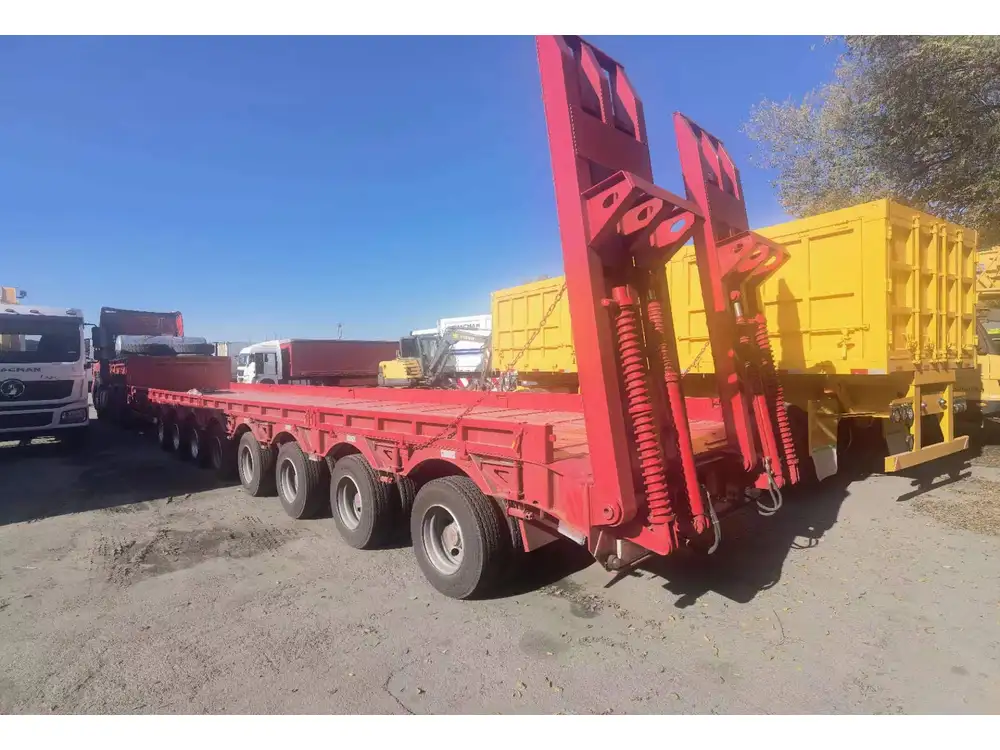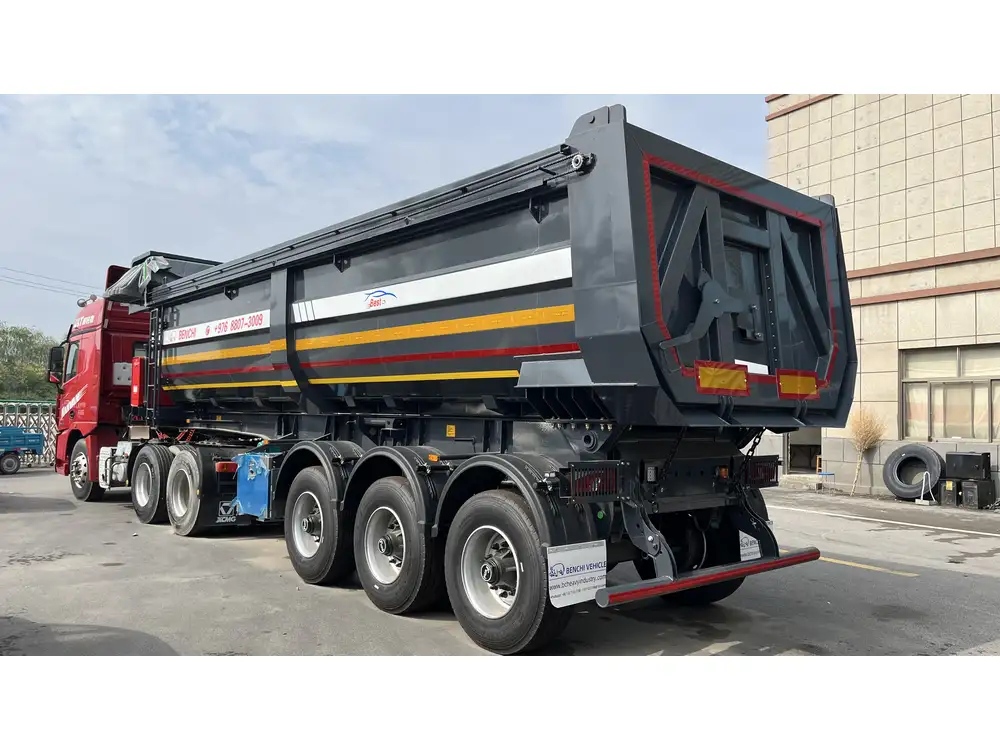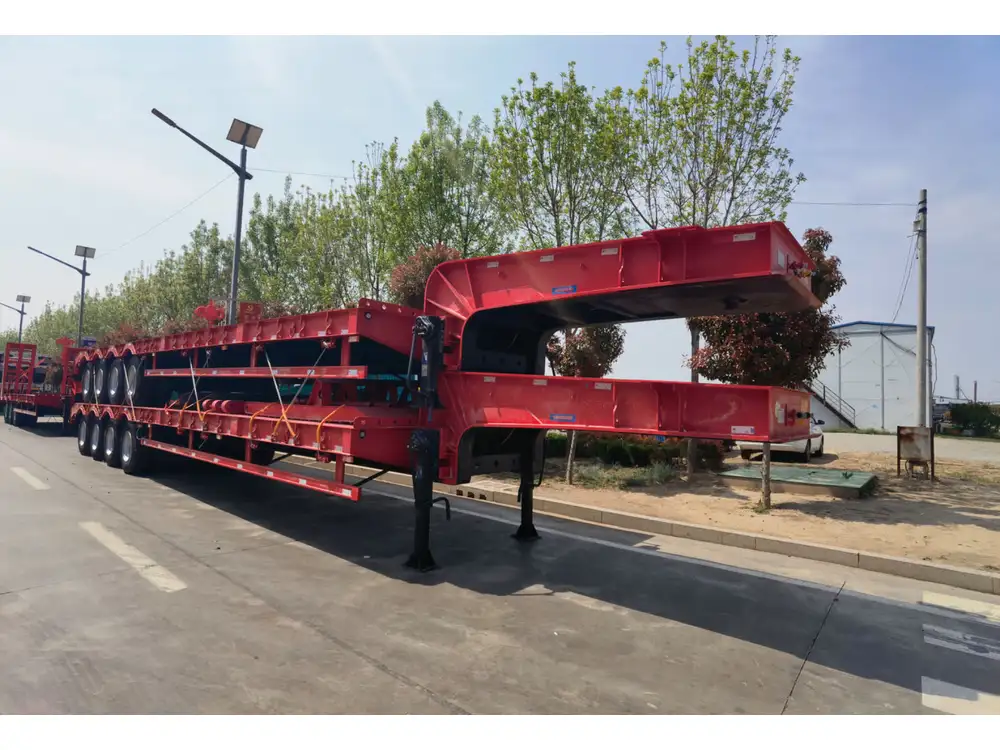In the dynamic world of logistics and transportation, understanding the intricate details of transporter dimensions is paramount for optimizing efficiency, ensuring compliance, and maximizing profitability. At CarMax Vehicle, we specialize in crafting semi-trailers that not only meet but exceed industry standards, providing solutions tailored to diverse transportation needs. This comprehensive guide delves deep into the nuances of transporter dimensions, offering insights that empower businesses to make informed decisions.
Understanding Transporter Dimensions
Transporter dimensions refer to the specific measurements that define a semi-trailer’s size and capacity. These dimensions include length, width, height, and weight capacity, each playing a critical role in determining the suitability of a trailer for specific cargo and routes.
Key Components of Transporter Dimensions
| Dimension | Description | Importance |
|---|---|---|
| Length | Total length of the trailer from front to back. | Determines cargo capacity and maneuverability on roads. |
| Width | Measurement across the trailer from side to side. | Affects stability and the ability to fit within road regulations. |
| Height | Distance from the ground to the top of the trailer. | Influences clearance requirements, especially under bridges. |
| Weight Capacity | Maximum load the trailer can safely carry. | Ensures compliance with legal weight limits and safety standards. |

The Importance of Proper Dimensions in Semi-Trailers
Selecting the appropriate dimensions for a semi-trailer is not merely a logistical consideration but a strategic business decision. Proper dimensions ensure:
- Regulatory Compliance: Adhering to regional and national transportation laws regarding trailer sizes and weight limits.
- Operational Efficiency: Enhancing fuel efficiency and reducing wear and tear by optimizing trailer size for specific routes.
- Cargo Safety: Preventing overloading and ensuring secure transport of goods to minimize damage risks.
- Cost Management: Balancing initial investment with long-term operational costs by choosing trailers that align with business needs.
Standard Semi-Trailer Dimensions
While dimensions can vary based on the type of cargo and regional regulations, several standard sizes are prevalent in the industry. Understanding these standards is crucial for optimizing trailer selection.
Common Dimensions
| Trailer Type | Length Range (feet) | Width (feet) | Height (feet) | Weight Capacity (tons) |
|---|---|---|---|---|
| Dry Van | 48 – 53 | 8.5 | 13.5 | 20 – 33 |
| Flatbed | 48 – 53 | 8.5 | 9 | 20 – 33 |
| Refrigerated | 48 – 53 | 8.5 | 13.5 | 20 – 33 |
| Tank | 40 – 53 | 8.5 | Varies | 20 – 33 |
| Double and Triple Trailers | 80+ | 8.5 | 13.5 | 40 – 60+ |

Regional Variations
Different regions may have specific regulations affecting trailer dimensions. For instance:
- United States: Maximum width usually 8.5 feet, with length and height varying by state.
- Europe: Width typically up to 2.55 meters (~8.37 feet), with lengths and heights differing across countries.
- Asia: Diverse standards depending on the country, with common widths ranging from 2.4 to 2.6 meters.
Compliance with Transportation Regulations
Ensuring that semi-trailers adhere to transportation regulations is non-negotiable. Non-compliance can result in hefty fines, operational delays, and safety hazards.
Key Regulatory Bodies and Standards
- Federal Motor Carrier Safety Administration (FMCSA): Regulates dimensions and weights in the United States.
- European Union Regulations: Sets standards for member countries, including dimensions and safety requirements.
- National Highway Traffic Safety Administration (NHTSA): Oversees regulations related to vehicle safety and dimensions.

Essential Compliance Considerations
- Maximum Legal Dimensions: Adhering to the maximum allowable length, width, height, and weight to avoid penalties.
- Route-Specific Restrictions: Being aware of infrastructure limitations such as bridge heights and road width constraints.
- Safety Standards: Ensuring trailers meet stability, braking, and lighting requirements set by regulatory bodies.
Maximizing Load Capacity within Dimensional Constraints
Balancing load capacity with dimensional restrictions is a critical aspect of efficient transportation. Overloading not only violates regulations but also poses significant safety risks.
Strategies for Optimal Load Management
- Cargo Optimization: Utilizing space efficiently by organizing cargo to maximize volume without exceeding weight limits.
- Weight Distribution: Ensuring even distribution of weight to maintain trailer stability and prevent undue stress on axles.
- Use of Modular Systems: Implementing modular loading techniques to allow flexibility in cargo arrangement within the trailer’s dimensions.

Technological Solutions
- Load Monitoring Systems: Employing sensors and software to track real-time weight distribution and prevent overloading.
- Advanced Design Features: Integrating design elements such as adjustable supports and reinforced structures to enhance load capacity without increasing dimensions.
Choosing the Right Transporter Dimensions for Your Business Needs
Selecting the appropriate semi-trailer dimensions requires a thorough analysis of your specific transportation requirements, including:
- Type of Cargo: Different goods may necessitate specialized trailer dimensions, such as refrigerated trailers for perishable items.
- Route Characteristics: Frequent routes with tight turns or low-clearance bridges may require more compact trailer dimensions.
- Fleet Composition: Balancing trailer sizes within your fleet to accommodate varying cargo types and volumes efficiently.
Customized Solutions by CarMax Vehicle
At CarMax Vehicle, we understand that each business has unique transportation needs. Our semi-trailers are available in a range of standardized dimensions and can be customized to align perfectly with your operational requirements. Whether you need a compact flatbed for urban deliveries or a large refrigerated trailer for long-haul perishable goods, we have the expertise to deliver the ideal solution.

Innovations in Semi-Trailer Design for Optimal Dimensions
The transportation industry is continuously evolving, with innovations aimed at enhancing efficiency, compliance, and sustainability. Recent advancements in semi-trailer design focus on optimizing dimensions without compromising functionality.
Key Innovations
- Aerodynamic Designs: Reducing drag through streamlined shapes, contributing to better fuel efficiency and higher load capacity within dimensional limits.
- Lightweight Materials: Utilizing high-strength, lightweight materials to decrease overall trailer weight, allowing for increased cargo load within the same dimensions.
- Modular Designs: Creating trailers with adjustable sections to accommodate varying cargo sizes and optimize space utilization dynamically.
- Smart Technology Integration: Incorporating IoT devices and automated systems for real-time monitoring of trailer dimensions, load distribution, and compliance adherence.
Future Trends
- Electric and Autonomous Trailers: Integrating electric propulsion and autonomous driving technologies, necessitating design adjustments to accommodate batteries and sensors without altering overall dimensions.
- Sustainable Construction: Emphasizing eco-friendly materials and manufacturing processes to reduce environmental impact while maintaining optimal transporter dimensions.

CarMax Trailer: Your Partner in Optimal Transport Solutions
Choosing the right semi-trailer is a strategic decision that can significantly impact your business operations. At CarMax Trailer, we pride ourselves on delivering high-quality, dimension-optimized trailers that cater to a wide range of transportation needs.
Why Choose CarMax Trailer?
- Customization Expertise: Tailored solutions ensuring your trailer dimensions align perfectly with your specific requirements.
- Quality Assurance: Rigorous testing and quality control processes to guarantee durability and compliance with all relevant standards.
- Innovative Designs: Incorporating the latest advancements in trailer design to enhance efficiency and performance.
- Comprehensive Support: From initial consultation to after-sales service, our team is dedicated to supporting your transportation endeavors.
Client Success Stories
Numerous businesses have transformed their logistics operations with CarMax Trailer’s semi-trailers. From improved load capacities to enhanced fuel efficiencies, our clients consistently report increased operational effectiveness and cost savings.

Conclusion
In the realm of transportation and logistics, understanding and optimizing transporter dimensions is a cornerstone of operational success. At CarMax Vehicle, we are committed to providing semi-trailers that not only meet but exceed industry standards, ensuring your business thrives in a competitive landscape. By meticulously balancing dimensions with load capacities, regulatory compliance, and innovative design, we empower your operations to achieve new heights of efficiency and reliability.
Frequently Asked Questions (FAQs)
1. What are the standard dimensions for a semi-trailer in the United States?
In the United States, standard semi-trailer dimensions typically include a length of 48 to 53 feet, a width of 8.5 feet, and a height of approximately 13.5 feet. The weight capacity usually ranges from 20 to 33 tons, depending on the trailer type and configuration.

2. How do transporter dimensions affect fuel efficiency?
Transporter dimensions significantly impact aerodynamics and overall weight, both of which influence fuel efficiency. Streamlined designs reduce air resistance, while lightweight materials minimize total trailer weight, leading to better fuel economy and lower operational costs.
3. Can transporter dimensions be customized to fit specific cargo requirements?
Yes, transporter dimensions can be customized to accommodate specific cargo needs. CarMax Vehicle offers tailored semi-trailer solutions, ensuring that dimensions such as length, width, and height are optimized for your unique transportation requirements.
4. What regulations should I be aware of when selecting semi-trailer dimensions?
When selecting semi-trailer dimensions, it is essential to be aware of regional and national transportation regulations governing maximum length, width, height, and weight limits. Compliance with these regulations ensures legal operation and avoids potential fines and penalties.

5. How does load distribution impact the safety and efficiency of a semi-trailer?
Proper load distribution is crucial for maintaining trailer stability, ensuring safe maneuvering, and optimizing load capacity. Uneven weight distribution can lead to handling difficulties, increased wear on trailer components, and heightened risk of accidents. Utilizing load monitoring systems and strategic cargo placement can enhance both safety and efficiency.



